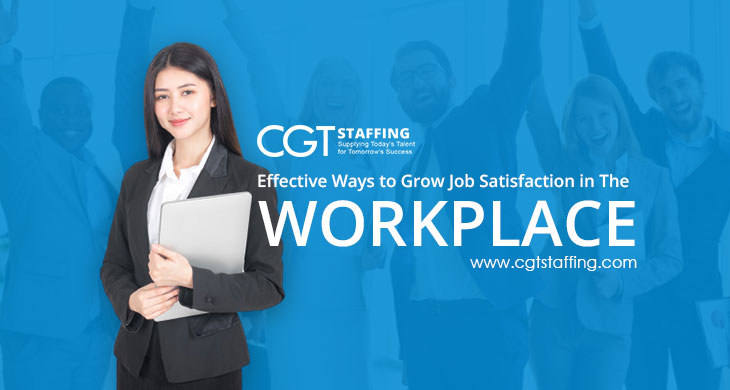Businesses rely heavily on being able to make profits that sustain their operations and support functions. However, sustainable profits are usually derived from better output, both in terms of quantity and quality. Every business has teams of individuals working together towards shared goals. But the real differentiator between a successful workplace and an average one is how satisfied the employees who work there actually feel.
Motivated and passionate workers will always have a greater drive to perform than the average worker. Job satisfaction has always been an important component when motivating employees. Therefore, many businesses may find it worthwhile to pay attention to certain key job satisfaction factors and identify any room for improvement. Read on to find out more about how you can start building an employer brand tailored around being a workplace staffed by satisfied and motivated employees.
Table of Contents
Understanding the Importance of Job Satisfaction
Before we move on to discussing how to boost satisfaction levels among your teams, it may be a good idea to first examine why job satisfaction is so crucial in the first place. In very basic terms, satisfaction levels indicate workers believe they are doing meaningful work and offering a key role in the functioning and growth of the larger business.
The jobs with the highest satisfaction aren’t always the highest-paying, high-powered positions in a glitzy corporate employer. In most cases, they are typically the ones where workers are cognizant of how they fit into the overall business structure and how the work they deliver helps the business on its path to meet its short-term and long-term goals.
So why is having a satisfied and motivated workforce so important? Job satisfaction statistics indicate a positive relationship between job satisfaction and improved performance. Satisfied workers will invariably have a great performance appraisal to show at the end of the year, barring any disruptive circumstances.
However, being a variable factor, job satisfaction levels can often involve adjusting different variables in a delicate but measurable way. If you’re unsure how to incorporate this into your employee retention policy try the ideas listed below as useful starting points.
Reading Suggestion: Learn How Maternity Leave Policies Apply to American Employers and Workers
Improve Employee Engagement
The biggest cause behind dissatisfied workers is often a lack of engagement. A lack of engagement can arise for many reasons. However, most of these reasons are often a simple case of a misperception a worker may have about their given role.
A little course correction and being more open to your workforce’s concerns can be of significant use in keeping workers engaged. The engagement process begins as early as the first instance a candidate responds to your talent acquisition strategies and should continue until the exit interview, or even after, if possible.
Invest in Helping Workers Grow and Develop Their Skills
Do you have talented workers who seem to struggle with targets that should be easy for them to achieve? No, that does not necessarily mean you have a bad hire or slacker on your hands. A bad performance review does not always indicate incompetence. It is far more likely to indicate obstructions that a worker faces, and may even point towards certain limitations that prevent them from delivering optimal performance.
Moreover, if you’re not paying attention, the effect of performance appraisal on job satisfaction (especially a bad one) can snowball. The trick is identifying any skill gaps or needs for specialized training that can help employees feel like they’re growing their skill sets. This will equip them for better performance and increase their satisfaction with their roles simultaneously.

Create a Healthy, Inclusive, and Support-Focused Culture
Nobody likes to spend much time in a hostile work environment. Workers are usually going to spend a significant part of their day in the office, which means a toxic, hostile, or bigoted work culture will inevitably increase employee turnover. Workplace stress is sometimes unavoidable, but unnecessary instances should always be eliminated. The relationship between job stress and job satisfaction is an inversely proportional one if the stress levels become debilitating instead of motivating, often leading to employees leaving your workforce.
But an employee finally resigning comes much, much later than the employee losing satisfaction and interest. By contrast, a healthy corporate culture, especially one that is inclusive, discrimination-free, and supportive in its workforce management approach is generally more conducive to higher satisfaction levels. Ultimately, the kind of work culture you offer will translate into how satisfied most of your workforce is.
Place People in Roles Based on Their Strengths
The impact of employee empowerment on job satisfaction can never be understated. Empowered workers feed off the amount of trust and autonomy they enjoy, and this is something that usually drives them to excel at their roles. But to ensure you are empowering your workers correctly, you need to broaden your recruitment paradigm.
A more holistic approach among recruiters (including a third-party staffing agency) can help you source talent based on obvious and demonstrable strengths. All you have to do from that point on is place them in roles that are naturally suited to these strengths. The success and empowerment derived from being in a role they are good at will usually boost job satisfaction.
Reading Suggestions: Reasons to Consider Outsourcing Your Direct Hiring Process
Offer Recognition and Rewards
Workers may not always expect to be praised for their regular work. But when they are denied due recognition and credit for a work achievement, employees can often feel disenfranchised from their employer. Luckily, there is a very simple fix to this: offer them the recognition they deserve.
For example, firms offering medical staffing solutions will usually offer appreciation certificates, cash bonuses, and a company-wide recognition of their best performers. This has two interesting facets in terms of improving motivation and satisfaction.
Create Career Development and Leadership Programs
Career growth and leadership development opportunities are things that can help you acquire more motivated candidates. It can also help supplemental third-parties like a staffing agency in Houston can use this as a key-value factor in pitching your employer brand.
But it isn’t enough just to promise these activities. You need to be proactive in identifying the ideal candidates for career growth and leadership development. These will not just be potential successors to key management personnel, but ambassadors for your employer brand. Their presence among your workforce can often have a multiplier-like impact on satisfaction levels.
Frequently Asked Questions:
What is job satisfaction?
Job satisfaction is an overlap between the study of organizational behavior and human performance.
Why is job satisfaction important?
It boosts worker productivity, company morale, and results in better output and revenues.
What are four causes of loss in job satisfaction?
Job dissatisfaction typically arises from (among other factors) perceptions about unfair compensation, limited career growth opportunities, toxic work cultures, and unempathetic bosses.
How can managers increase their employee’s job satisfaction?
Improve engagement, offer better career development, create leadership opportunities, and offer recognition and praise.
Is employee satisfaction and job satisfaction the same?
Employee satisfaction refers to the broader workforce, but job satisfaction typically deals with individuals.
How stress affects job satisfaction among employees?
Stress can often be a catalyst for growth, but unhealthy levels can deteriorate employee health and wellbeing, ultimately leading to employee turnover.
Is there a relationship between job satisfaction and turnover?
Yes, most workplaces with high job satisfaction rates have lower turnover rates. Conversely, lowered job satisfaction can increase employee turnover to alarming levels.
